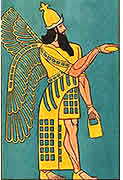| |||||||||||||||||||||||||||||||||
| Facts > Pagan Christs > Mithras | |||||
| Glycon | Simon | Apollonius of Tyana | Pythagoras | Orpheus | |
| Isis / Osiris | Dionysus | Zalmoxis | Kore | Samothrace | |
| Heroes | Attis | Adonis | Mithras | Other godmen |
| Mithras 3,000 BC - a dying, resurrected savior |
|
Mithras was originally Persian. Before Rome. When the Christ myth was new Mithras and Mithraism were already ancient. Worshiped for centuries as God's Messenger of Truth, Mithras was long revered by the Persians (Zoroastrianism) and the Indians (see the Vedic literature). |
|
Sadly there's a lot we don't know about this faith that comforted million of souls. Early Christians established the dominance of their religion by exterminating Mithras' faithful, razing His temples, burning His sacred texts. We do know Every year in Rome, in the middle of winter, the Son of God was born
one more, putting an end to darkness. Every year at first minute of
December 25th the temple of Mithras was lit with candles,
priests in in white
Baptism in the blood of the bull (taurobolium)—early Mithraic rituals brought about the transformation and Salvation of His adherents—an ascent of the soul of the adherent into the realm of the divine. From the wall of a Mithraic temple in Rome: "And thou hast saved us by shedding the eternal blood."
|




